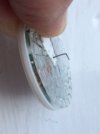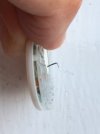Hi everyone. My first time on this forum. I have been using Freestyle Libre system for at least a couple of years since we were first able to justify getting them on prescription. Unfortunately I often have sensors fail when I am changing them. When the needle is punched into my arm it bends through a right angle. I have pictures (attached). Unfortunately you don't know they are bent until an hour later which is the time period you have to wait before the reader will read the new sensor. So, it is a real pain. I have even had one sensor fall to bits internally (unbeknown to me) and I ended up punching nothing into my arm, again only discovered an hour later. Recently I experienced something new. The sensor did work for a couple of days and then failed but I don't know why.
I have always complained to the manufacturer and they will happily replace them but you never get any feedback on how big this problem is and what we can do about it. It's just a call centre at the end of the day. So, as long as I have got sufficient stock I don't bother complaining now. My concern was whether I am doing something wrong but I am very careful with site selection and the process of changing sensors in line with instructions. I am very slim but always ensure the sensor goes into the muscle NOT bone LOL!

I have posted this on our DAFNE (Dose Adjustmen For Normal Eating) forum but sadly it is not used very much so I have had no responses so far.
Any of you out there have this problem. Any suggestions, help etc???? Would be nice to know I'm not alone.
I have always complained to the manufacturer and they will happily replace them but you never get any feedback on how big this problem is and what we can do about it. It's just a call centre at the end of the day. So, as long as I have got sufficient stock I don't bother complaining now. My concern was whether I am doing something wrong but I am very careful with site selection and the process of changing sensors in line with instructions. I am very slim but always ensure the sensor goes into the muscle NOT bone LOL!


I have posted this on our DAFNE (Dose Adjustmen For Normal Eating) forum but sadly it is not used very much so I have had no responses so far.
Any of you out there have this problem. Any suggestions, help etc???? Would be nice to know I'm not alone.
